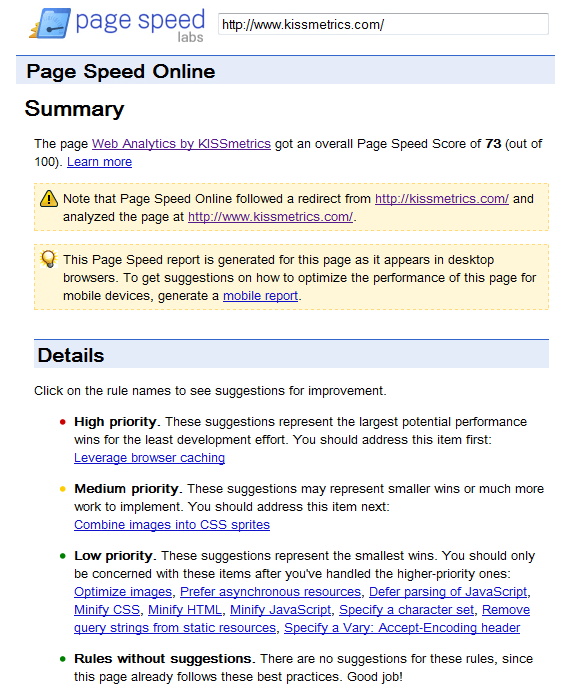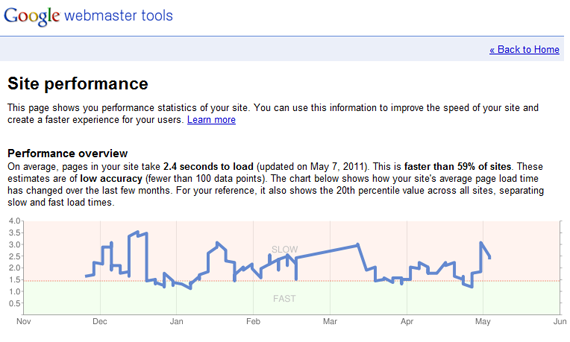
Why Decreasing Page Load Time Can Drastically Increase Conversions for your business.
Can the speed of your website really have that much of an effect on your sales? Even if your site isn’t loading too slowly, can it still be improved? And how does Google factor into all of this? You might be surprised.
According to surveys done by Akamai and Gomez.com, nearly half of web users expect a site to load in 2 seconds or less, and they tend to abandon a site that isn’t loaded within 3 seconds. 79% of web shoppers who have trouble with web site performance say they won’t return to the site to buy again and around 44% of them would tell a friend if they had a poor experience shopping online.
This means you’re not just losing conversions from visitors currently on your site, but that loss is magnified to their friends and colleagues as well. The end result – lots of potential sales down the drain because of a few seconds difference.
What
What can I do to decrease my website load times?
There is no easy way to do this because there are many factors that go into making your website load faster. If you're a technical person the guide below is a good place to start to understand what is causing some of the loading issues for your site. If you're not a technical person, our team of professionals here at youradvertisingagency.com will get the job done for you so you can focus on to more important things like running your business.
So how do you test and measure your site’s load time while squeezing every drop of performance out of your website?
How Fast Does Your Site Load? Here Are Some Tools And Resources:
Websites generally “weigh” around 130 KB, including things like images, scripts and stylesheets. Sites like Web Page Test or Firefox browser plugins like Page Speed can give you a starting point.
Page Speed Online
In April of this year, Google also introduced its own web-based tool, accessible via Google Labs, called Page Speed Online. It’s available as a web-based tool as well as a Chrome extension.
Here is an example of when you run Page Speed Online for the domain KISSmetrics.com:

With it, you can quickly get an overview of high priority, medium and low priority fixes that can help increase your page speed. Many of these suggestions are fairly technical, so it’s a good idea to have your web developer by your side when going over them, to see just how many are feasible for your particular site.
Google Analytics Plugin by Yoast
If you’re using WordPress and the Google Analytics plugin by Joost de Valk (Yoast.com), you’ll also be glad to know that it now incorporates the Site Speed feature too. Among other things, it can help you understand how quickly or slowly your page loads across different parts of the world and different browsers.
Google Webmaster Tools

In addition, you can also check your site load time month by month using Google Webmaster Tools. Check out their “Labs” section for more details.
How to Decrease Page Load Time
Once you find out your page’s loading time, what can you do to shorten it? The following steps can help any site, no matter how fast, trim a few seconds off of its loading time:
- Use GZIP compression – You’ll want to ask your web host if they use GZIP compression and deflation on their servers. These are two techniques that can significantly speed up a site, reducing file size by as much as 70% without degrading the quality of the images, video or the site at all. To see if your site is already GZIPPED, click here to run a simple test.
- Wrangle Your Javascript and Stylesheets – Have your scripts and CSS load in external files instead of cramping up each and every web pages. This way, the browser only has to load the files one time, rather than every time someone visits each page of your site. Ideally, put your external CSS in the portion of your site, and your external Javascript file as close to the tag as possible. This way, the browser isn’t bogged down wading through all those requests for external files right from the start. The only time you won’t want to do this is if the Javascript needs to load near the top of the page – such as to display a name or load up an image carousel.
- Optimize Your Images – In Photoshop or Fireworks, you can use the “Save for Web” option to drastically reduce image size. An image quality slider lets you see the visual trade-offs between graphic file size and crispness. Don’t have a graphics program? ImageOptim (Mac Only) or TinyPNG (Web based) can do the trick.
- Don’t Rely on HTML to Resize Images – HTML (and by extension, WordPress blogs), make it easy to create a smaller version of a larger graphic. But just because you load that smaller size, doesn’t mean it’s taking up any less room on the server. The browser still has to load the ENTIRE image, THEN check the width and height you want and THEN resize it accordingly.
- Cache Me If You Can – Content management systems like WordPress have plugins that will cache the latest version of your pages and display it to your users so that the browser isn’t forced to go dynamically generate that page every single time. Plugins like WP Super Cache can take a serious bite out of page load times.
- Don’t Confuse the Browser with Redirects – A 301 Redirect is the preferred way to change your site structure without losing any of that valuable search engine juice, but lots of 301 redirects piled together just confuse the browser and slow it down as it wades through the old destinations to get to the new one.
- Let the Network Carry the Load – If your site is extremely popular but you’re still having trouble getting your page load down to size, consider a Content Delivery Network (CDN) like Amazon Cloudfront. Content Delivery Networks work by serving pages depending on where the user is located. Faster access to a server near their geographical area means they get the site to load sooner.
So, Why Does Google Care About Load Time?
Google did an interesting experiment with regard to load times. Google Vice President Marissa Mayer asked web surfers – would you rather see 10 or 30 results for your Google search? The users agreed that 30 results per page sounded like a good idea. So Google implemented it on some results pages.
Then the shock came.
Pages that displayed 30 results each had traffic to them drop an astounding 20%. Google tested the loading difference between the 10 and 30 results pages and found that it was just half of a second. If half of a second made that much of a difference in how long users were willing to wait, how much of a difference could it make to your site if you carved a second or two off of load time?
Google, Page Load Time & SEO
Should you panic about your load time affecting your Google rankings? The great Matt Cutts says no – that it’s just one of over 200 signals they use in determining rank. But that’s not to say you should put it off either. Optimizing your page load time is a smart thing to do to help visitors get where they’re going faster, and it’s a better use of your time than obsessively tweaking your meta-tags. According to a recent post on SEOmoz, while site speed is a new signal, it doesn’t carry as much weight as the relevance of a page. Currently, fewer than 1% of search queries are affected by the site speed signal.
Speed Matters
Overall, while load time isn’t a significant contributor to Google rankings, it can contribute to the rise and fall of your conversion rate. Remember that for every second you shave off of load time, you’ll tend to boost customer confidence and trust in your site, and sow the seeds that will make them way to tell others about you. In those cases, a few seconds can make all the difference!



 In this ad, the focus is on top of funnel readers— entrepreneurs— who need a marketing automation tool. Instead of highlighting cost benefits, it encourages them to learn more about the tool first. This is great for lead generation.
In this ad, the focus is on top of funnel readers— entrepreneurs— who need a marketing automation tool. Instead of highlighting cost benefits, it encourages them to learn more about the tool first. This is great for lead generation. [
[ This Amazon ad is understandably trying to put a new spin on lawn equipment, but a BBQ generally isn’t what most readers equate to lawn equipment. Shifting the focus of the copy or using a lawnmower, would have made it immediately clear to readers what the ad is about.
This Amazon ad is understandably trying to put a new spin on lawn equipment, but a BBQ generally isn’t what most readers equate to lawn equipment. Shifting the focus of the copy or using a lawnmower, would have made it immediately clear to readers what the ad is about. This ad focuses on the value the product gives users. Rather than talking about cutting edge technology it simply highlights the time-saving benefits. Who wouldn’t want to lounge while something else cleaned?
This ad focuses on the value the product gives users. Rather than talking about cutting edge technology it simply highlights the time-saving benefits. Who wouldn’t want to lounge while something else cleaned? [
[
 Checking your Relevance score in AdEspresso is even simpler than that! As soon as you access your campaign’s dashboard you’ll be able to see the trends of your campaign’s relevance score and engagement over time.
Checking your Relevance score in AdEspresso is even simpler than that! As soon as you access your campaign’s dashboard you’ll be able to see the trends of your campaign’s relevance score and engagement over time.
 The value found with a product like Audible is the time it saves. Users can download and listen to a wide range of audiobooks while going about their daily routines. With this particular ad, readers are encouraged to try the service with a free download.
The value found with a product like Audible is the time it saves. Users can download and listen to a wide range of audiobooks while going about their daily routines. With this particular ad, readers are encouraged to try the service with a free download. The copy in this ad does a good job of forcing readers to think about how much they spend on groceries and how a meal kit delivery service can be better for their wallet. A powerful word like “shocked” promises something intriguing and pique’s curiosity.
The copy in this ad does a good job of forcing readers to think about how much they spend on groceries and how a meal kit delivery service can be better for their wallet. A powerful word like “shocked” promises something intriguing and pique’s curiosity. Key takeaway: To create scarcity, your Facebook ad copy should combine it with urgency. For example, “only for today, the first 100 customers save 50%.” If you’re able to find the right mix of urgency and scarcity, your ad will have accomplished getting users to take action.
Key takeaway: To create scarcity, your Facebook ad copy should combine it with urgency. For example, “only for today, the first 100 customers save 50%.” If you’re able to find the right mix of urgency and scarcity, your ad will have accomplished getting users to take action.